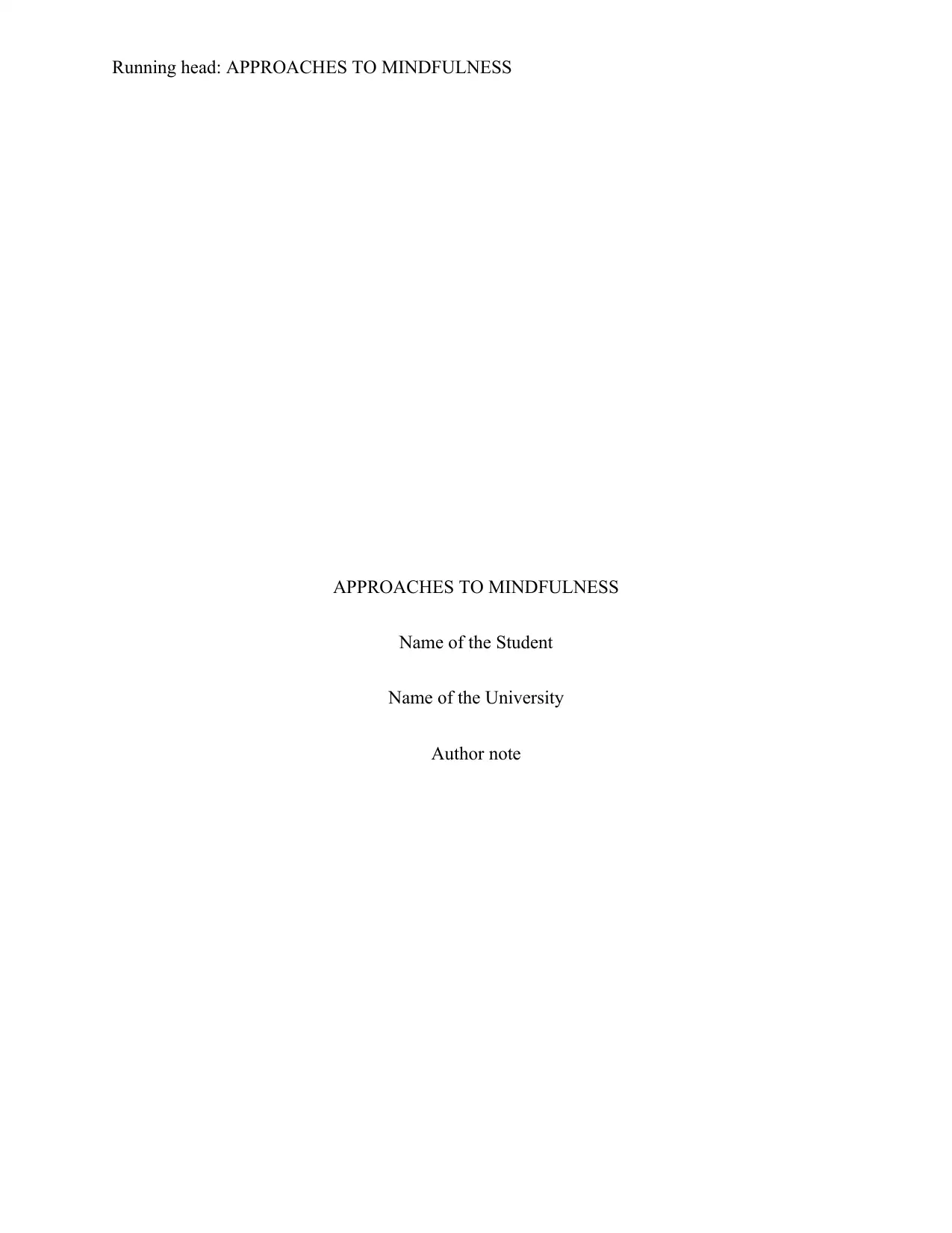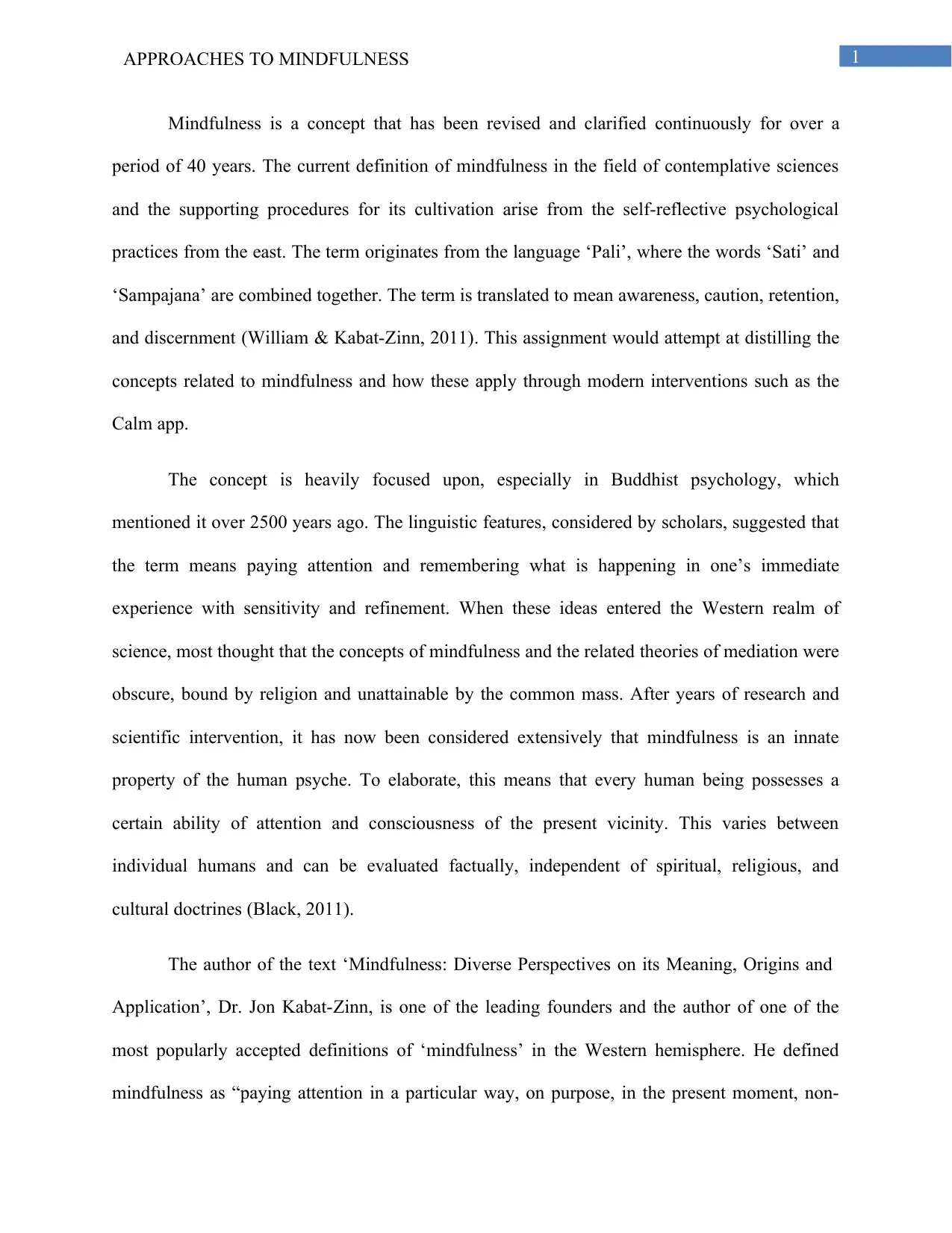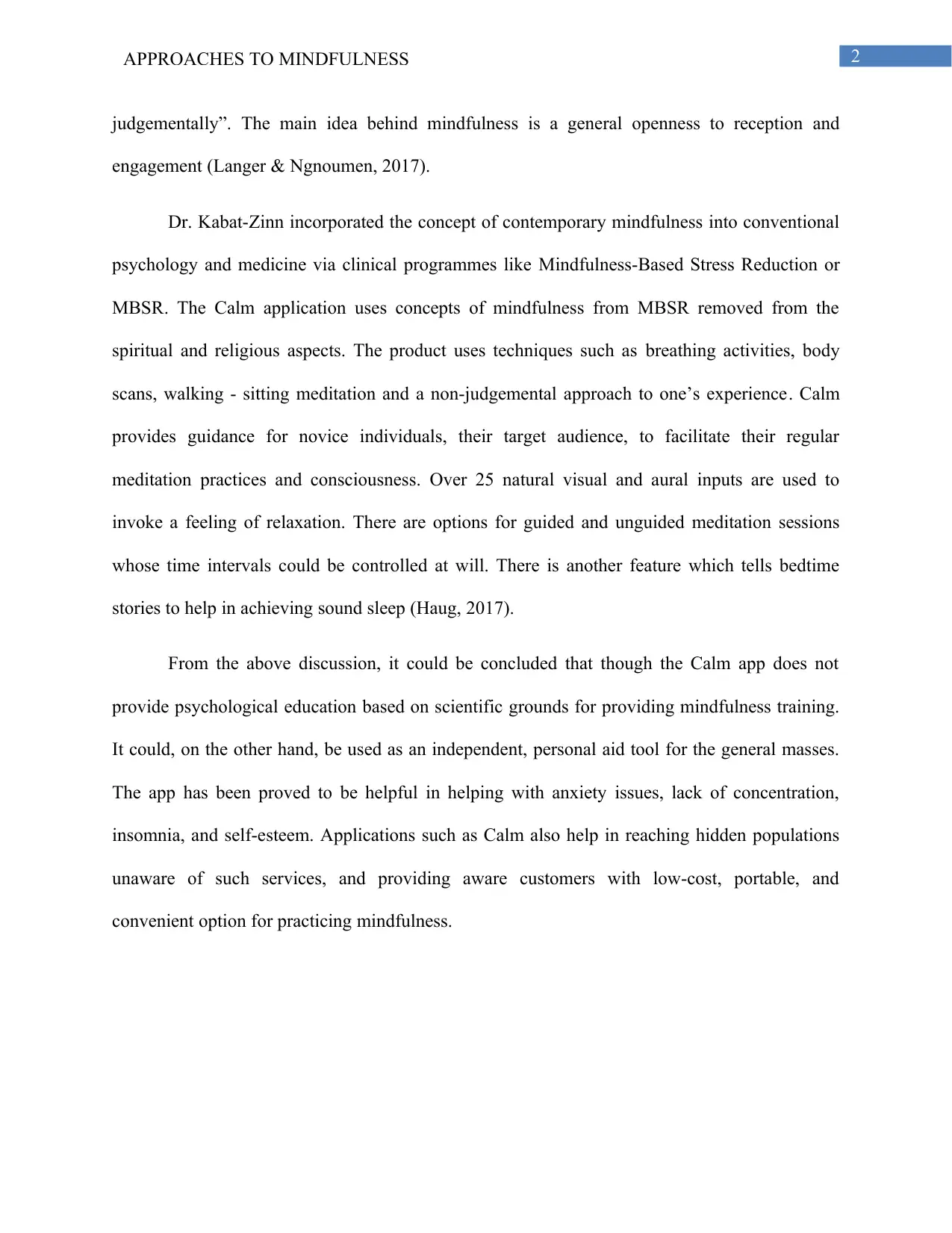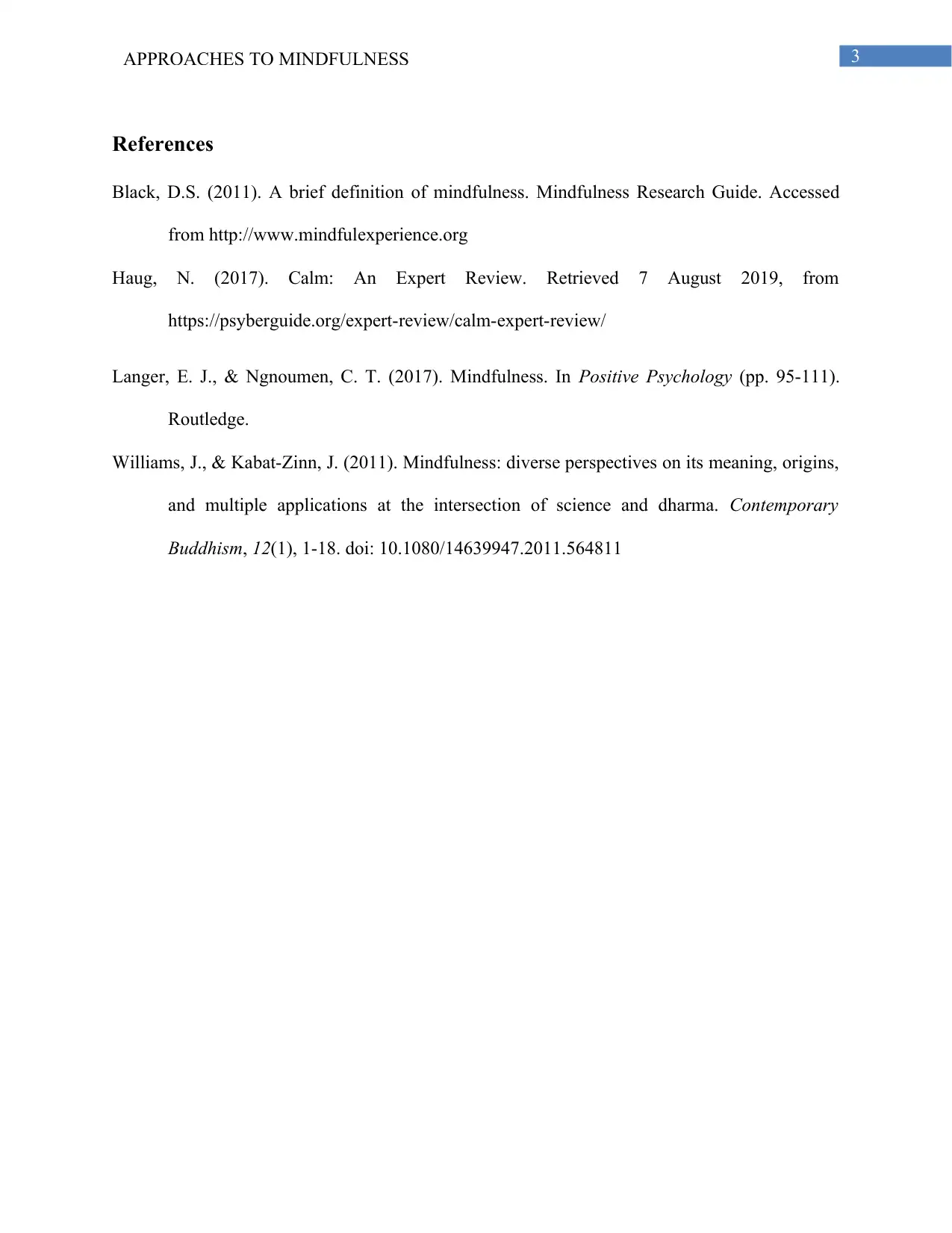Approaches to Mindfulness: Concepts, Applications, and the Calm App
VerifiedAdded on 2022/10/11
|4
|760
|14
Essay
AI Summary
This essay delves into the concept of mindfulness, tracing its origins in Eastern psychological practices and its evolution in Western science. It defines mindfulness according to Dr. Jon Kabat-Zinn as 'paying attention in a particular way, on purpose, in the present moment, non-judgementally.' The...

Running head: APPROACHES TO MINDFULNESS
APPROACHES TO MINDFULNESS
Name of the Student
Name of the University
Author note
APPROACHES TO MINDFULNESS
Name of the Student
Name of the University
Author note
Paraphrase This Document
Need a fresh take? Get an instant paraphrase of this document with our AI Paraphraser

1APPROACHES TO MINDFULNESS
Mindfulness is a concept that has been revised and clarified continuously for over a
period of 40 years. The current definition of mindfulness in the field of contemplative sciences
and the supporting procedures for its cultivation arise from the self-reflective psychological
practices from the east. The term originates from the language ‘Pali’, where the words ‘Sati’ and
‘Sampajana’ are combined together. The term is translated to mean awareness, caution, retention,
and discernment (William & Kabat-Zinn, 2011). This assignment would attempt at distilling the
concepts related to mindfulness and how these apply through modern interventions such as the
Calm app.
The concept is heavily focused upon, especially in Buddhist psychology, which
mentioned it over 2500 years ago. The linguistic features, considered by scholars, suggested that
the term means paying attention and remembering what is happening in one’s immediate
experience with sensitivity and refinement. When these ideas entered the Western realm of
science, most thought that the concepts of mindfulness and the related theories of mediation were
obscure, bound by religion and unattainable by the common mass. After years of research and
scientific intervention, it has now been considered extensively that mindfulness is an innate
property of the human psyche. To elaborate, this means that every human being possesses a
certain ability of attention and consciousness of the present vicinity. This varies between
individual humans and can be evaluated factually, independent of spiritual, religious, and
cultural doctrines (Black, 2011).
The author of the text ‘Mindfulness: Diverse Perspectives on its Meaning, Origins and
Application’, Dr. Jon Kabat-Zinn, is one of the leading founders and the author of one of the
most popularly accepted definitions of ‘mindfulness’ in the Western hemisphere. He defined
mindfulness as “paying attention in a particular way, on purpose, in the present moment, non-
Mindfulness is a concept that has been revised and clarified continuously for over a
period of 40 years. The current definition of mindfulness in the field of contemplative sciences
and the supporting procedures for its cultivation arise from the self-reflective psychological
practices from the east. The term originates from the language ‘Pali’, where the words ‘Sati’ and
‘Sampajana’ are combined together. The term is translated to mean awareness, caution, retention,
and discernment (William & Kabat-Zinn, 2011). This assignment would attempt at distilling the
concepts related to mindfulness and how these apply through modern interventions such as the
Calm app.
The concept is heavily focused upon, especially in Buddhist psychology, which
mentioned it over 2500 years ago. The linguistic features, considered by scholars, suggested that
the term means paying attention and remembering what is happening in one’s immediate
experience with sensitivity and refinement. When these ideas entered the Western realm of
science, most thought that the concepts of mindfulness and the related theories of mediation were
obscure, bound by religion and unattainable by the common mass. After years of research and
scientific intervention, it has now been considered extensively that mindfulness is an innate
property of the human psyche. To elaborate, this means that every human being possesses a
certain ability of attention and consciousness of the present vicinity. This varies between
individual humans and can be evaluated factually, independent of spiritual, religious, and
cultural doctrines (Black, 2011).
The author of the text ‘Mindfulness: Diverse Perspectives on its Meaning, Origins and
Application’, Dr. Jon Kabat-Zinn, is one of the leading founders and the author of one of the
most popularly accepted definitions of ‘mindfulness’ in the Western hemisphere. He defined
mindfulness as “paying attention in a particular way, on purpose, in the present moment, non-

2APPROACHES TO MINDFULNESS
judgementally”. The main idea behind mindfulness is a general openness to reception and
engagement (Langer & Ngnoumen, 2017).
Dr. Kabat-Zinn incorporated the concept of contemporary mindfulness into conventional
psychology and medicine via clinical programmes like Mindfulness-Based Stress Reduction or
MBSR. The Calm application uses concepts of mindfulness from MBSR removed from the
spiritual and religious aspects. The product uses techniques such as breathing activities, body
scans, walking - sitting meditation and a non-judgemental approach to one’s experience. Calm
provides guidance for novice individuals, their target audience, to facilitate their regular
meditation practices and consciousness. Over 25 natural visual and aural inputs are used to
invoke a feeling of relaxation. There are options for guided and unguided meditation sessions
whose time intervals could be controlled at will. There is another feature which tells bedtime
stories to help in achieving sound sleep (Haug, 2017).
From the above discussion, it could be concluded that though the Calm app does not
provide psychological education based on scientific grounds for providing mindfulness training.
It could, on the other hand, be used as an independent, personal aid tool for the general masses.
The app has been proved to be helpful in helping with anxiety issues, lack of concentration,
insomnia, and self-esteem. Applications such as Calm also help in reaching hidden populations
unaware of such services, and providing aware customers with low-cost, portable, and
convenient option for practicing mindfulness.
judgementally”. The main idea behind mindfulness is a general openness to reception and
engagement (Langer & Ngnoumen, 2017).
Dr. Kabat-Zinn incorporated the concept of contemporary mindfulness into conventional
psychology and medicine via clinical programmes like Mindfulness-Based Stress Reduction or
MBSR. The Calm application uses concepts of mindfulness from MBSR removed from the
spiritual and religious aspects. The product uses techniques such as breathing activities, body
scans, walking - sitting meditation and a non-judgemental approach to one’s experience. Calm
provides guidance for novice individuals, their target audience, to facilitate their regular
meditation practices and consciousness. Over 25 natural visual and aural inputs are used to
invoke a feeling of relaxation. There are options for guided and unguided meditation sessions
whose time intervals could be controlled at will. There is another feature which tells bedtime
stories to help in achieving sound sleep (Haug, 2017).
From the above discussion, it could be concluded that though the Calm app does not
provide psychological education based on scientific grounds for providing mindfulness training.
It could, on the other hand, be used as an independent, personal aid tool for the general masses.
The app has been proved to be helpful in helping with anxiety issues, lack of concentration,
insomnia, and self-esteem. Applications such as Calm also help in reaching hidden populations
unaware of such services, and providing aware customers with low-cost, portable, and
convenient option for practicing mindfulness.
⊘ This is a preview!⊘
Do you want full access?
Subscribe today to unlock all pages.

Trusted by 1+ million students worldwide

3APPROACHES TO MINDFULNESS
References
Black, D.S. (2011). A brief definition of mindfulness. Mindfulness Research Guide. Accessed
from http://www.mindfulexperience.org
Haug, N. (2017). Calm: An Expert Review. Retrieved 7 August 2019, from
https://psyberguide.org/expert-review/calm-expert-review/
Langer, E. J., & Ngnoumen, C. T. (2017). Mindfulness. In Positive Psychology (pp. 95-111).
Routledge.
Williams, J., & Kabat-Zinn, J. (2011). Mindfulness: diverse perspectives on its meaning, origins,
and multiple applications at the intersection of science and dharma. Contemporary
Buddhism, 12(1), 1-18. doi: 10.1080/14639947.2011.564811
References
Black, D.S. (2011). A brief definition of mindfulness. Mindfulness Research Guide. Accessed
from http://www.mindfulexperience.org
Haug, N. (2017). Calm: An Expert Review. Retrieved 7 August 2019, from
https://psyberguide.org/expert-review/calm-expert-review/
Langer, E. J., & Ngnoumen, C. T. (2017). Mindfulness. In Positive Psychology (pp. 95-111).
Routledge.
Williams, J., & Kabat-Zinn, J. (2011). Mindfulness: diverse perspectives on its meaning, origins,
and multiple applications at the intersection of science and dharma. Contemporary
Buddhism, 12(1), 1-18. doi: 10.1080/14639947.2011.564811
1 out of 4
Your All-in-One AI-Powered Toolkit for Academic Success.
+13062052269
info@desklib.com
Available 24*7 on WhatsApp / Email
![[object Object]](/_next/static/media/star-bottom.7253800d.svg)
Unlock your academic potential
© 2024 | Zucol Services PVT LTD | All rights reserved.

